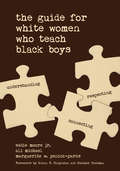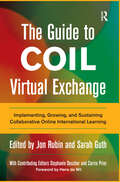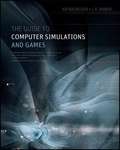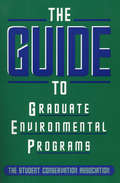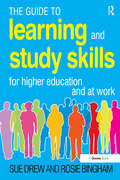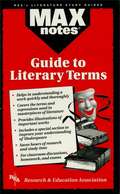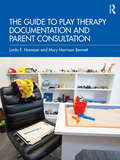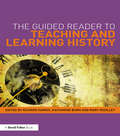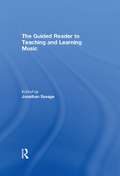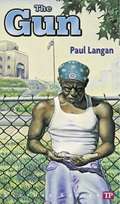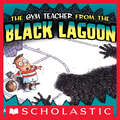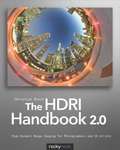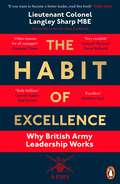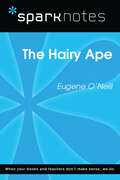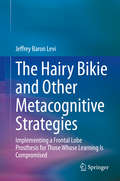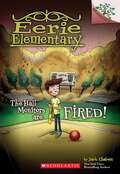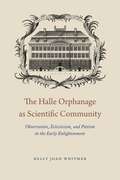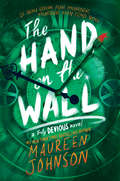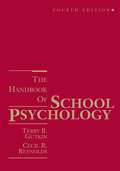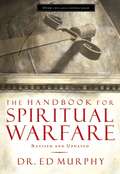- Table View
- List View
The Guide for White Women Who Teach Black Boys
by Marguerite W. Penick-Parks Eddie Moore Jr. Ali MichaelSchools that routinely fail Black boys are not extraordinary. In fact, they are all-too ordinary. If we are to succeed in positively shifting outcomes for Black boys and young men, we must first change the way school is “done.” That’s where the eight in ten teachers who are White women fit in . . . and this urgently needed resource is written specifically for them as a way to help them understand, respect and connect with all of their students. <p><p> So much more than a call to call to action—but that, too!—The Guide for White Women Who Teach Black Boys brings together research, activities, personal stories, and video interviews to help us all embrace the deep realities and thrilling potential of this crucial American task.
The Guide to COIL Virtual Exchange: Implementing, Growing, and Sustaining Collaborative Online International Learning
by Jon Rubin Sarah GuthThis is the authoritative guide to implementing COIL Virtual Exchange, conceived, and co-edited by one of the originators of this innovative approach to internationalization, Jon Rubin. COIL, the acronym for Collaborative Online International Learning, is a central modality of what has come to be known as virtual exchange. Since its first iteration in 2002, it has gradually established itself as a mature pedagogy that is being increasingly implemented across the world and is validated by a growing body of research. COIL Virtual Exchange at its most essential is a bi-lateral online exchange involving the integration of existing courses across two, or sometimes more, institutions that are geographically and/or culturally distinct. To launch a COIL VE course, the instructor of a class at a higher education institution in one location links online with a professor and his or her class in another region or country. Together, their students engage and develop joint projects, usually over a continuous five to eight-week period. Compared to the limited number of students worldwide who can engage in study abroad, COIL VE potentially opens up more equitable and inclusive participation in international education and intercultural experiences to all students, involves them in rigorous disciplinary and interdisciplinary studies, and promotes close and constructive engagement with students with different cultural perspectives.While many COIL courses are launched by individual instructors, based on their research connections and online outreach, they are being increasingly supported and led by dedicated COIL Coordinators who facilitate virtual exchanges and provide professional development. This comprehensive guide covers COIL VE pedagogy, provides examples of what takes place in the COIL classroom, and explores what instructors and staff need to know to facilitate and support a variety of COIL courses across the curriculum. It addresses how institutional stakeholders, especially those in leadership positions, can develop and embed a successful COIL initiative at their institution. It offers varied perspectives of COIL viewed from different institutional and cultural vantage points -- from research universities, community and technical colleges, and university systems -- and describes how COIL VE is developing in five different world regions, presenting eleven case studies.The book concludes with a guide to thirteen global organizations that support COIL and other forms of VE. Additionally, the book provides links to the COIL Connect for Virtual Exchange website (https://coilconnect.org) which includes an updated directory of organizations, an expanding database of faculty and institutions participating in COIL and looking for partners, course templates, survey data, and case studies.This book offers faculty and administrators across the world -- whether formally involved in international education, in service-learning and community engagement, or wanting to incorporate a cross-cultural perspective in their disciplinary courses -- theoretical foundations, guidance on effective collaboration, and the strategic and pedagogical considerations to develop robust COIL VE courses and programs.
The Guide to Computer Simulations and Games
by J. R. Parker K. BeckerThe first computer simulation book for anyone designing or building a gameAnswering the growing demand for a book catered for those who design, develop, or use simulations and games this book teaches you exactly what you need to know in order to understand the simulations you build or use all without having to earn another degree. Organized into three parts, this informative book first defines computer simulations and describes how they are different from live-action and paper-based simulations.The second section builds upon the previous, with coverage of the technical details of simulations, a detailed description of how models are built, and an explanation of how those models are translated into simulations. Finally, the last section develops four examples that walk you through the process from model to finished and functional simulation, all of which are created using freely available software and all of which can be downloaded.Targets anyone interested in learning about the inner workings of a simulation or game, but may not necessarily be a programmer or scientistOffers technical details on what simulations are and how they are built without overwhelming you with intricate jargonBreaks down simulation vs. modeling and traditional vs. computer simulationsExamines verification and validation and discusses simulation toolsWhether you need to learn how simulations work or it's something you've always been curious about but couldn't find the right resource, look no further. The Guide to Computer Simulations and Games is the ideal book for getting a solid understanding of this fascinating subject.
The Guide to Graduate Environmental Programs
by Scott D. IzzoThe Guide to Graduate Environmental Programs provides over 160 profiles of graduate programs across the country that offer curricula related to the environment. Following is a description of how the book was researched and the profiles compiled: The research process began with a list, drawn up by career center staff at University of California at Santa Barbara, of 412 environmental programs, departments, and schools within universities across the country. The list was based on a literature search, queries over the Internet, and contact with environmental professionals and associations. Certificate-only programs were not included. Selection preference was given to programs mentioned repeatedly by environmental professionals, and to those drawing a more diverse student body. Of the 412 graduate programs queried, 156 programs completed and returned their surveys. Each completed survey was reworked into a profile. Schools that did not respond to the mailing were contacted twice by phone to remind them to return the survey. To supplement this information, and to ensure that the most noteworthy programs were included in the guide, additional profiles were compiled for a select number of key programs that failed to return their surveys. These latter profiles were based on literature review and personal interviews. Most of the information provided was accurate as of November 1994 - the date by which the surveys were completed - and some follow-up verification was conducted during the summer of 1996, before the book went into production. There are an ever-expanding number of programs in the environmental field, and existing programs are constantly evolving. Readers should therefore expect to continue to encounter ongoing changes in names, titles, and phone numbers.
The Guide to Learning and Study Skills: For Higher Education and at Work
by Rosie Bingham Sue DrewSkills in learning and studying are vital to ensure success in higher education study, whether at undergraduate or postgraduate level, in university, college or in the workplace. Skills are needed in reflection, analysis, communication and recording information to produce good work, to engage effectively in a group, to carry out a project or perform well in exams; personal skills are needed to handle time and pressure and to relate to others on a course or in the workplace. This new guide builds on the hugely successful materials the authors have developed over the last 15 years. Along with highly practical guidance on traditional learning skills, The Guide to Learning and Study Skills provides direction for students on learning in a blended environment; the increased use of personal and professional development planning, continuing professional development and work-based learning.
The Guide to Literary Terms (MAXNotes Literature Guides)
by Gail RaeREA's MAXnotes Guide to Literary Terms REA's book is a concise, easy-to-use guide to the literary terms and devices which high school and undergraduate students encounter most often. The main body of the book is an alphabetical listing of approximately 150 of the most-commonly encountered literary terms or devices. The entries are simplified to enable students with no knowledge of the terms to become comfortable with their uses in a short time. Each entry in the book includes a definition of the literary term or device, a history of the term's use and origin, and specific references to texts in which the term has been used.
The Guide to Play Therapy Documentation and Parent Consultation
by Linda E. Homeyer Mary Morrison BennettThe Guide to Play Therapy Documentation and Parent Consultation guides play therapists through the case-documentation process, from the initial inquiry for services through intake session, diagnosis, treatment planning, session notes, and termination summary. There’s a special focus on writing session notes, one of the areas in which play therapists most often request additional training. Chapters also identify play themes, explore clinical theories and case conceptualization, and guide play therapists from the playroom to the paperwork. The authors include several examples of case notes and treatment plans completed from a variety of theoretical perspectives, and vignettes and case studies illustrate ways to connect with caregivers, strategies for working with challenging caregivers, addressing difficult topics at different ages and stages of parenting (how to talk about sex, screen time, co-parenting, etc.), and much more. The book also includes a thorough discussion of ways to structure parent consultations to facilitate the therapeutic process. Expansive appendices provide many case examples and tips to explain and demonstrate documentation, and the authors provide form templates in the text and on the book’s website.
The Guided Reader to Teaching and Learning
by Denis HayesFeaturing extracts from some of the most influential education writers in recent times The Guided Reader to Teaching and Learning is an essential compendium providing insight, guidance and clarity about key issues affecting practitioners at every level. All extracts have been carefully chosen to represent education issues that affect every practising teacher. Each extract is accompanied by an introduction to the passage, key words and phrases and a summary of key points. In addition, there are questions to prompt discussion, suggestions about areas for possible investigation and references to other key readings to extend thinking. Uniquely, the book provides cross-referencing between extracts to facilitate a more complete understanding of how different issues overlap and how competing arguments have to be evaluated. Combining both theoretical and practical dimensions into one handy and engaging volume, The Guided Reader to Teaching and Learning includes extracts, summaries and discussions about the following: the teacher effective teachers and teaching motivating learners teaching approaches teaching younger children managing teaching and learning other adults in the school child development ways that pupils learn learning climate learning styles thinking and learning assessment and learning. The book will be of considerable interest to trainee and newly qualified teachers who are seeking to gain a higher qualification, notably at Masters degree level. More experienced teachers and teaching assistants wishing to upgrade their qualifications will also find the book an invaluable source of information and guidance.
The Guided Reader to Teaching and Learning History
by Richard Harris Katharine Burn Mary WoolleyThe Guided Reader to Teaching and Learning History draws on extracts from the published work of some of the most influential history education writers, representing a range of perspectives from leading classroom practitioners to academic researchers, and highlighting key debates surrounding a central range of issues affecting secondary History teachers. This book brings together key extracts from classic and contemporary writing and contextualises these in both theoretical and practical terms. Each extract is accompanied by an introduction, a summary of the key points and issues raised, questions to promote discussion and suggestions for further reading to extend thinking. Taking a thematic approach and including a short introduction to each theme, the chapters include: The purpose of history education; Pupil perspectives on history education; Assessment and progression in history; Inclusion in history; Diversity in history; Teaching difficult issues; Technology and history education; Change and continuity; Historical Interpretations; Professional development for history teachers. Aimed at trainee and newly qualified teachers including those working towards Masters level qualifications, as well as existing teachers, this accessible, but critically provocative text is an essential resource for those that wish to deepen their understanding of History Education.
The Guided Reader to Teaching and Learning Music
by Jonathan SavageThe Guided Reader to Teaching and Learning Music draws on extracts from the published work of some of the most influential education writers to provide insight, guidance and clarity about key issues affecting Music teachers. The book brings together key extracts from classic and contemporary writing and contextualises these in both theoretical and practical terms. The extracts are accompanied by a summary of the key ideas and issues raised, questions to promote discussion and reflective practice, and annotated further reading lists to extend thinking. Taking a thematic approach and including a short introduction to each theme, the chapters cover: ? Analysing your own work as a music teacher; Concepts of musicality; Notions of musical development and progression; Pedagogies for teaching music musically; Music inside and outside the school; Formal, informal and non-formal approaches to music education; Productive methods of assessment and transition for music education; Creativity and music education; Supporting the gifted and talented in music; Using ICT within music education. ? Aimed at trainee and newly qualified teachers including those working towards Masters-level qualifications, as well practicing teachers, this accessible, but critically provocative text will be an essential resource for all teachers that wish to deepen their understanding of Music Education.
The Gun (Bluford Series #6)
by Paul LanganTyray, a high school freshman, is used to bullying other kids, but one day a boy fights back and Tyray is humiliated in front of his classmates. As if that isn't enough to manage, Tyray's older brother is in jail and his dad beats Tyray when he gets angry. Feeling hopeless and frustrated, Tyray decides to get a gun and take back control of his life. But will he use it?
The Gym Teacher from the Black Lagoon (Black Lagoon Adventures)
by Mike ThalerIt's another scary day at the Black Lagoon. . . .There's a new gym teacher transferring over from the junior high, and Hubie is worried. The junior high students say he's big, mean, and blows his whistle a lot. Will Hubie really have to run a lap around the world to pass Mr. Green's class? Will he be able to lift Mr. Green's pickup truck and climb up a rope while it's on fire?Hubie doesn't want to go to gym class anymore!
The H. A. Rey Treasury of Stories (Dover Children's Classics)
by Margaret Rey H. A. Rey"I totally fell in love with this book. I've read the Curious George books hundreds of times, but I've never seen any of these. They're fun and have cheerful, silly illustrations that the kids will love. Everyone should read this one!" — St. Francis (Pius X Library) Elementary School From the author of the Curious George series comes this collection of four humorous and marvelously illustrated stories:Tit for Tat concerns kindness to animals and portrays a place where horses ride in carriages drawn by men and women, fish catch humans, cows lasso cowboys, and dogs walk people.Elizabite: Adventures of a Carnivorous Plant uses rhyming couplets to recount the humorous antics of a hungry plant in a botanist's laboratory.Billy's Picture, a tale of art and individualism, tells of Billy the Bunny's attempts to paint a picture. Each of his friends has a different idea about how it should look ― and they all want to help. (co-written with Margret Rey)Zebrology offers a wordless celebration of the common ground that lies beneath appearances.
The HDRI Handbook 2.0
by Christian BlochHigh dynamic range imaging (HDRI) takes photography to a whole new level. It opens the door to unprecedented creative freedom in digital post-processing by capturing everything from the darkest shadows to the brightest highlights. HDRI means truly lossless image editing, full exposure control, and the ability to master any scene's contrast without artificial lighting and preserve all light from a scene so it can be digitally revisited anytime in the future. Combined with panoramic photography, this captured light can even be used to render 3D objects with a deceivingly realistic appearance. In 2007, The HDRI Handbook was the first book to present this revolutionary new field to a larger audience. These days HDRI is a fully mature technology available to everyone. Real estate and landscape photographers have adopted it as part of their regular workflow, it has become one of the hottest trends for ambitious amateurs and creative professionals alike, and the modern movie industry would be completely dysfunctional without it. Now The HDRI Handbook 2. 0 redefines its own gold standard. It has been completely rewritten and is packed with practical hints and tips, background knowledge, reference tools, breathtaking artist portfolios, and inspiring interviews. The book includes dozens of new step-by-step tutorials, which are easy to follow with the material provided on the DVD. Beginners will get a methodically solid introduction and advanced readers will be able to refine their technique to perfection. Whether you are a photographer, CG artist, compositor, or cinematographer, this book is sure to enlighten you. Topics include: Understanding the foundation of HDRI HDR software comparisons and evaluations Capturing HDR images: today and tomorrow Tonemapping for creating superior prints HDR image processing and compositing Shooting and stitching HDR panoramas Image-based lighting and CG rendering 2. 0 updates include: New cameras, sensors, and HDR beamsplitter rigs Open Camera Controller for endless auto-bracketing Correct RAW pre-processing and ghost removal Dozens of practical, easy-to-follow tutorials A structured approach to tonemapping, inspired by Ansel Adams Set etiquette and tips for capturing HDR panos for visual effects Seven artist spotlights showing unique perspectives on HDRI Seven crossword puzzles: a fun way to test yourself A companion DVD loaded with goodies
The Habit of Excellence: Why British Army Leadership Works
by Lt Col Langley SharpThe official British Army book on what makes its leadership so successful, and how to become a better leader yourself - whatever your field. ___________________'If you want to become a better leader, read this book' Eddie Jones'An extraordinary read for any leader. Truly brilliant' General Stanley McChrystal, author of Team of Teams'Excellent. Offers proven tools and strategies' Matthew Syed___________________ The Habit of Excellence is a unique insight into British Army leadership, explaining what makes it unique, what makes it so effective and what civilians can take from it to become better leaders themselves. Drawing on the latest research in military history, business, sociology, psychology and behavioural science, and with compelling illustration from British Army operations across the centuries, Lt Col Langley Sharp MBE goes beyond the latest leadership fads to distil into one peerlessly authoritative work the essence of leading and leadership from one of the world's most revered institutions.___________________'Excellent. It's hard to see how any leader, whatever their field, wouldn't benefit from reading and rereading it' New Statesman 'Offers lessons for all managers' Financial Times 'Valuable in any walk of life' General Sir Mike Jackson, former Chief of the General Staff 'Very readable. I could not recommend this exceptional book more' General The Lord David Richards, former Chief of the Defence Staff 'Comprehensive and clearly written' Karin von Hippel, Director-General of RUSI 'Terrific. Full of insights and lessons' General David Petraeus, former Director of the CIA
The Hair Book (Bright & Early Books(R))
by GRAHAM TETHERAn easy reader about hair--and all the things you can do with it--that's perfect for fans of classic Dr. Seuss concept books like The Foot Book and The Eye Book!This super-simple, rhymed riff features a charming cast of human and animal characters sporting all kinds of hair--short, long, curly, straight, dark, fair, braided, tied, washed, dyed--you name it! Written for children learning to read on their own, it's filled with words and concepts kids encounter every day. Perfect for reading aloud or reading alone, it's also great for starting discussions about which kinds of animals have hair and which do not. With bright, energetic artwork by Andrew Joyner, this is the kind of fun, easy reader that is hard for kids to put down!
The Hairy Ape (SparkNotes Literature Guide Series)
by SparkNotesThe Hairy Ape (SparkNotes Literature Guide) by Eugene O'Neill Making the reading experience fun! Created by Harvard students for students everywhere, SparkNotes is a new breed of study guide: smarter, better, faster.Geared to what today's students need to know, SparkNotes provides:chapter-by-chapter analysis explanations of key themes, motifs, and symbols a review quiz and essay topics Lively and accessible, these guides are perfect for late-night studying and writing papers.
The Hairy Bikie and Other Metacognitive Strategies: Implementing a Frontal Lobe Prosthesis for Those Whose Learning Is Compromised
by Jeffrey Baron LeviThe book contains practical and innovative strategies to train clients with Traumatic Brain Injury, Autism, Intellectual Impairment and Behavioural Disorders to compensate for their deficits and to function independently within their environments. The book is a result of 30 years of working directly with clients who are experiencing problems with organization, memory, learning, problem solving and anger management. The book is highly recommended for practitioners working with clients with a range of disability in educational, community or work settings and is a valuable tool to researchers and tertiary institutions to impart this knowledge to future practitioners. The book is highly recommended to be included in a cognitive rehabilitation course for counsellors, neuropsychologists, rehabilitation consultants and vocational rehabilitation consultants. It would be highly relevant for a section in a Special Education course and for school psychologists, special education and mainstream teachers working with children with learning and behavioural disorders.
The Half-Opened Door: Discrimination and Admissions at Harvard, Yale, and Princeton, 1900-1970
by Marcia SynnottBy the turn of the twentieth century, academic nativism had taken root in elite American colleges—specifically, Harvard, Yale, and Princeton. White, Anglo-Saxon, Protestant hegemony was endangered by new kinds of student, many of them Catholic and Jewish immigrants. The newcomers threatened to displace native-born Americans by raising academic standards and winning a disproportionate share of the scholarships.The Half-Opened Door analyzes the role of these institutions, casting light on their place in class structure and values in the United States. It details the origins, history, and demise of discriminatory admissions processes and depicts how the entrenched position of the upper class was successfully challenged. The educational, and hence economic, mobility of Catholics and Jews has shown other groups—for example, African Americans, Asian Americans, and Spanish-speaking Americans—not only the difficulties that these earlier aspirants had in overcoming class and ethnic barriers, but the fact that it can be done.One of the ironies of the history of higher education in the United States is the use of quotas by admissions committees. Restrictive measures were imposed on Jews because they were so successful, whereas benign quotas are currently used to encourage underrepresented minorities to enter colleges and professional schools. The competing claims of both the older and the newer minorities continue to be the subject of controversy, editorial comments, and court cases—and will be for years to come.
The Hall Monitors are Fired! (Eerie Elementary #Eight)
by Jack ChabertSam Graves and his friends Lucy and Antonio have used their positions as hall monitors to thwart Orson Eerie's attacks on the students of Eerie Elementary--but now Orson is determined to get them fired before his next attack, planned for the annual Kickball Showdown.
The Halle Orphanage as Scientific Community: Observation, Eclecticism, and Pietism in the Early Enlightenment
by Kelly Joan WhitmerFounded around 1700 by a group of German Lutherans known as Pietists, the Halle Orphanage became the institutional headquarters of a universal seminar that still stands largely intact today. It was the base of an educational, charitable, and scientific community and consisted of an elite school for the sons of noblemen; schools for the sons of artisans, soldiers, and preachers; a hospital; an apothecary; a bookshop; a botanical garden; and a cabinet of curiosity containing architectural models, "naturalia," and scientific instruments. Yet, its reputation as a Pietist enclave inhabited largely by young people has prevented the organization from being taken seriously as a kind of scientific academy even though, Kelly Joan Whitmer shows, this is precisely what it was. "The Halle Orphanage as Scientific Community" calls into question a long-standing tendency to view German Pietists as anti-science and anti-Enlightenment, arguing that these tendencies have drawn attention away from what was actually going on inside the orphanage. Whitmer shows how the orphanage s identity as a scientific community hinged on its promotion of philosophical eclecticism as a tool for assimilating perspectives and observations and working to perfect one s abilities to observe methodically. Because of the link between eclecticism and observation, Whitmer reveals, those teaching and training in Halle s Orphanage contributed to the transformation of scientific observation and its related activities in this period. "
The Halloween Parade (The Kids in Ms. Colman's Class #9)
by Ann M. MartinFrom the bestselling author of the generation-defining series The Baby-sitters Club comes a series for a new generation!School is always fun in Ms. Colman's class! Hannie is having problems with Karen and Nancy. But Hannie thinks she can fix things. She is going to get cool Halloween costumes for all the kids in Ms. Colman's class. Then their class will win prizes. And Karen and Nancy will make up with Hannie. But the Costumes never come! Has Hannie ruined Halloween for everyone?
The Hand on the Wall (Truly Devious #3)
by Maureen JohnsonNew York Times and USA Today bestseller!New York Times bestselling author Maureen Johnson delivers the witty and pulse-pounding conclusion to the Truly Devious series as Stevie Bell solves the mystery that has haunted Ellingham Academy for over 75 years.Ellingham Academy must be cursed. Three people are now dead. One, a victim of either a prank gone wrong or a murder. Another, dead by misadventure. And now, an accident in Burlington has claimed another life. All three in the wrong place at the wrong time. All at the exact moment of Stevie’s greatest triumph . . . She knows who Truly Devious is. She’s solved it. The greatest case of the century.At least, she thinks she has. With this latest tragedy, it’s hard to concentrate on the past. Not only has someone died in town, but David disappeared of his own free will and is up to something. Stevie is sure that somehow—somehow—all these things connect. The three deaths in the present. The deaths in the past. The missing Alice Ellingham and the missing David Eastman. Somewhere in this place of riddles and puzzles there must be answers.Then another accident occurs as a massive storm heads toward Vermont. This is too much for the parents and administrators. Ellingham Academy is evacuated. Obviously, it’s time for Stevie to do something stupid. It’s time to stay on the mountain and face the storm—and a murderer.In the tantalizing finale to the Truly Devious trilogy, New York Times bestselling author Maureen Johnson expertly tangles her dual narrative threads and ignites an explosive end for all who’ve walked through Ellingham Academy.Praise for the Truly Devious series:“Readers, hang tight: there’s one more round to come, and if the signs are right, it’ll be to die for.” —Publishers Weekly (starred review)“The Agatha Christie-like ecosystem pairs with lacerating contemporary wit, and alternating past and present scenes makes for a multilayered, modern detective story.” —New York Times Book Review“Remember the first time reading Harry Potter and knowing it was special? There’s that same sense of magic in the introduction of teen Sherlock-in-training Stevie Bell.” —USA Today (four stars)“Be still, my Agatha-Christie-loving beating heart.” —Bustle
The Handbook Of School Psychology
by Cecil R. Reynolds Terry B. GutkinAs the standard reference in the field, this edited handbook focuses on how a school psychologist can operate and create change within the educational system instead of focusing solely on the diagnosis and treatment of an individual. Chapters have been updated and revised to provide a contemporary view of the field.
The Handbook for Spiritual Warfare: Revised and Updated
by Ed MurphyYour guide to understanding all dimensions of spiritual warfare!The Handbook for Spiritual Warfare is the most thorough treatment available of biblical and theological foundations and practical concerns for spiritual warfare. Further revised and updated for the 21st century.THE BOOK:Equips leaders and mature believersComprehensive coverage of all 3 dimensions of spiritual conflict: the World, the Flesh, and the DevilEndorsed by Frank Peretti, Dr. C. Peter Wagner, and others
